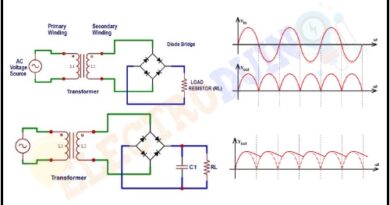Half Wave Rectifier – Circuit Diagram and Working Principle,
Hello friends! Welcome back to ElectroDuino. This blog is based on Half Wave Rectifier. Here we will discuss What is Half Wave Rectifier, Working Principle, Circuit Diagram, Waveforms, Formula, Applications, Advantages, and Disadvantages.
What is a Rectifier?
The Rectifier is a simple electronic circuit construct by a single PN junction diode or multiple PN junction diodes that converts alternating current (AC) into direct current (DC). The process of convert alternating current (AC) to direct current (DC) is called Rectification.

The rectifiers are used to convert the alternating voltage (AC) into a continuous voltage (DC) because most electronic devices, like TVs, audio systems, and computers are operated by DC voltage. If we apply alternating voltage (AC) to operate these DC electronic devices, they can be damaged.
We know that a PN junction diode conducts electric current in one direction from the anode to its cathode and blocks electric current in opposite direction. That why using this principle to construct different types of rectifiers. Rectifiers are classified into different types based on the number of diodes or arrangement of diodes in the Rectifiers circuit. The rectifiers are mainly classified into two categories, these are Half Wave Rectifier and Full Wave Rectifier.
What is a Half Wave Rectifier?
A half-wave rectifier is the simplest form of rectifier made of one PN junction diode that only allows one half-cycle (either positive half cycle or negative half cycle) of input alternating current (AC) signal to pass, blocking the other half-cycle, for transform AC voltage into pulsating DC voltage.
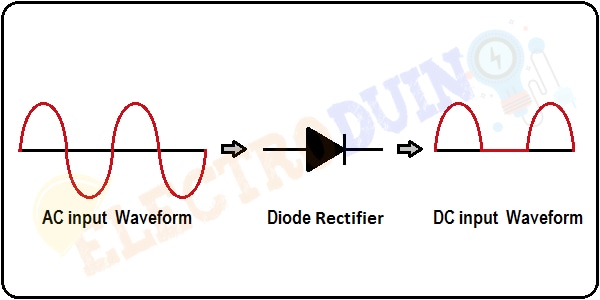
|
Also See |
Working/Operation of Half Wave Rectifier (Theory)
The half-wave rectifier circuit is the simplest form of rectifier circuits, it requires only one PN junction diode for construction. The alternating current is represented by a sinusoidal waveform that has positive and negative half-cycle. When the Alternative current (AC) is passed through a half-wave rectifier circuit, it allows only one half-cycle (positive or negative half-cycle) of the AC voltage and will block the other half-cycle, as result in the AC input voltage converts into DC output voltage.
A complete half-wave rectifier circuit consists of three main parts, these are a step-down transformer, a diode, a resistive load, and also need an AC voltage source.
The AC voltage source supplies Alternating Current to the entire circuit. Basically, a diode is operated in very small voltage. When we apply a large amount of AC voltage will cause damage to the diode. That’s why a step-down transformer is used to decrease the AC voltage. The diode is a PN junction semiconductor material that allows the flow of current only in one direction while it blocks the current flow in another path. The resistor is used as a load. The diode is connected between the transformer and load resistor.
The half-wave rectifier circuit can be passed through it only a positive half-cycle or a negative half-cycle that depends on the configuration of the diode in the circuit. According to the diode configuration (forward bias or reverse bias) in the circuit, Half Wave rectifier circuits are classified into two categories: Positive half-wave rectifiers and Negative half-wave rectifiers.
Positive half-wave rectifiers
When the diode configures as forward bias condition in the half-wave rectifier circuit, then the circuit passed only positive half-cycle through it and blocks the negative half-cycle, this configuration is known as a Positive half-wave rectifier. In the Positive half-wave rectifier circuit Anode or positive terminal of the diode connected to the transformer and the Cathode or negative terminal connected to the load resistor. So, the diode is in forward bias condition. When we applied high AC voltage to the primary side of the step-down transformer, then we will get a low AC voltage as output at the secondary side which is applied across the diode.

During the positive half cycle of the low AC voltage, the diode will be forward biased and the diode will work as a closed switch that allows the current to flow through the diode. So, the positive half-cycle of AC voltage will appear across the load resistor.

During the negative half cycle of the low AC voltage, the diode will be reverse biased and the diode will work as an open switch that blocks the current flows through the diode. So, the negative half-cycle of AC voltage does not appear across the load resistor and the output voltage is equal to zero.
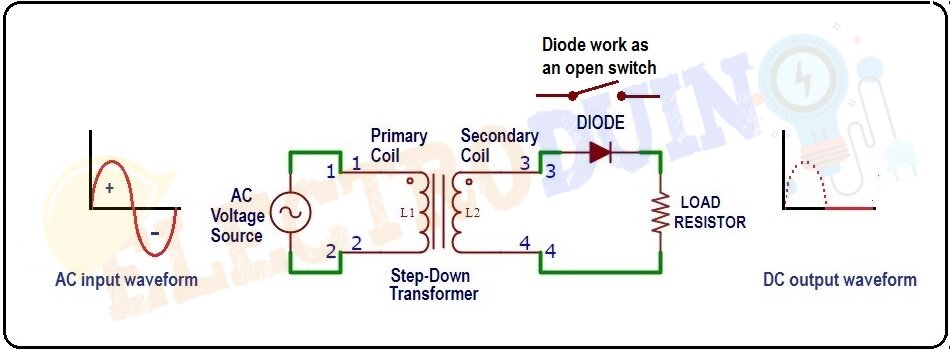
As result, we get the DC output voltage across the load resistor. The DC output voltage is a series of the positive half cycle or positive sinusoidal pulses.
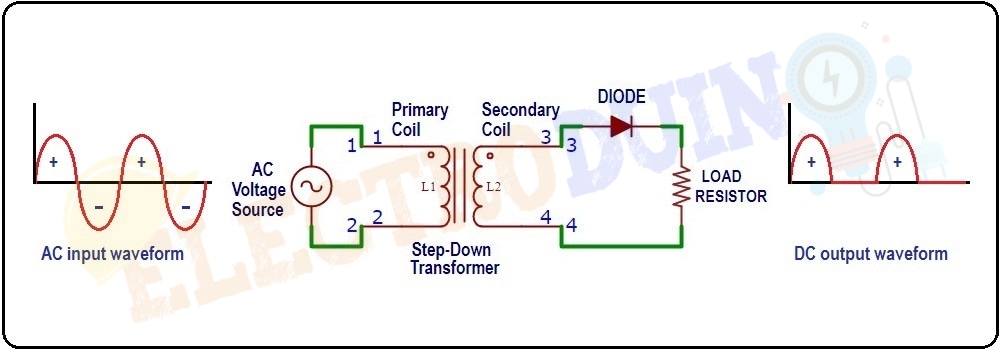
Output Waveform of Positive half wave rectifier
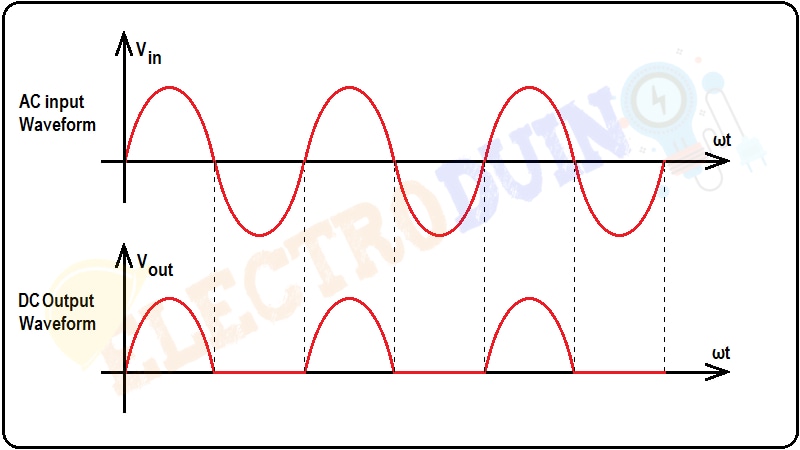
Negative half-wave rectifiers
When the diode in reverse bias condition, the half-wave rectifier circuit passed through it only negative half-cycle and block the positive half-cycle, this configuration is known as a Negative half-wave rectifier. In this rectifier circuit Cathode or negative terminal of the diode connected to the transformer and the Anode or positive terminal connected to the load resistor. So, the diode is in reverse bias condition.
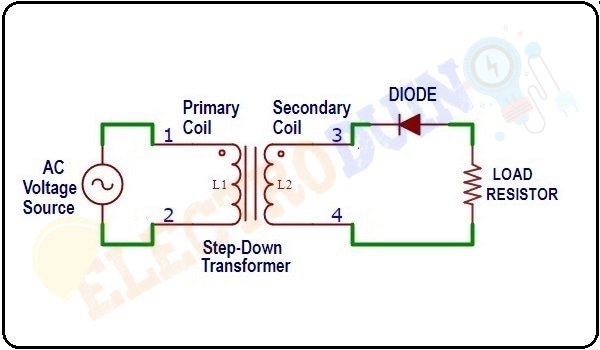
During the Positive half cycle of the low AC voltage, the diode will be reverse biased and the diode will work as an open switch that blocks the current flows through the diode. So, the Positive half-cycle of AC voltage does not appear across the load resistor and the output voltage is equal to zero.

During the Negative half cycle of the low AC voltage, the diode will be forward biased and the diode will work as a closed switch that allows the current to flow through the diode. So, the negative half-cycle of AC voltage will appear across the load resistor.

As result, we get the DC output voltage across the load resistor. The DC output voltage is a series of negative half cycles or negative sinusoidal pulses.
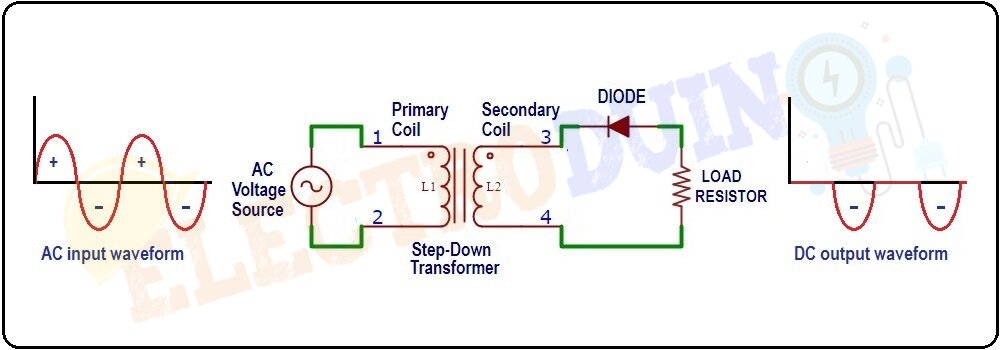
Output Waveform of Negative half wave rectifier

Half Wave Rectifier with Capacitor Filter
Generally, the output of a half-wave rectifier is a pulsating DC waveform that increases to a maximum and then decreases to zero. This type of DC output can’t be used for any practical applications because DC equipment requires a constant DC supply to operate. That’s why we need to convert pulsating DC waveform into constant DC waveform.
Filters are one type of electronic component that used to convert the pulsating waveform into constant DC waveforms. A capacitor or inductor can be used as a filter to convert the pulsating DC to constant DC. Here we use a capacitor filter (C) which is parallelly connected to the load resistor.
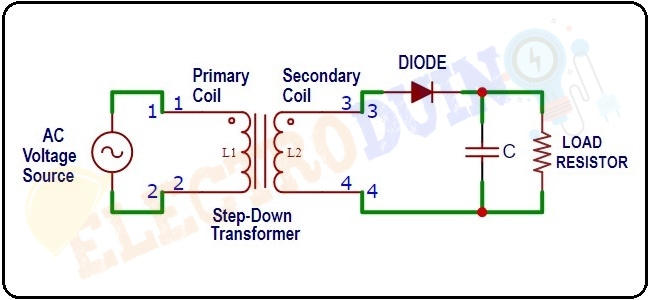
During the positive half cycle, the diode will be forward biased that allow the current to flow through the diode. So, the positive half-cycle will appear across the load resistor, and at the same time, the capacitor starts charging. The capacitor charging continues until the positive half cycle reaches its peak value (Vp).
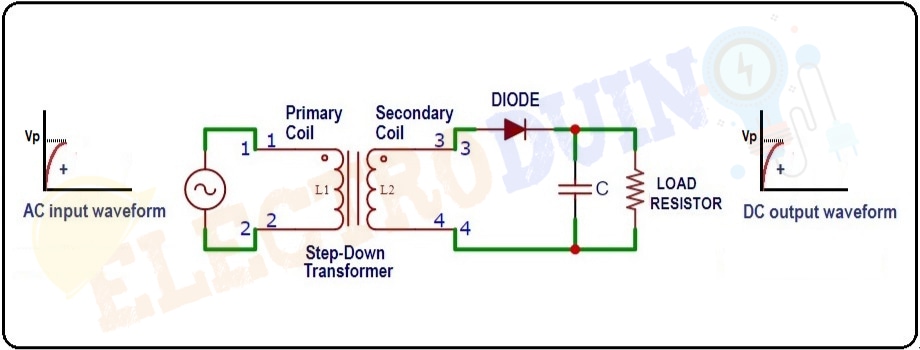
During the negative half cycle, the diode will be reverse biased that blocks the current flow through the diode. So, the negative half-cycle of AC voltage does not appear across the load resistor. But this time the capacitor start discharges through the load resistor until the next positive half-cycle arrives.

As result in we get a constant DC output.

The half-wave rectifier waveform after using a filter is shown below in the figure:

Applications of Half Wave Rectifier
The half-wave rectifiers are not hugely used like full-wave rectifiers. It has some uses, these are:
- Rectification applications
- Use for signal demodulation applications
- Use for signal peak applications
Advantages and Disadvantages
Advantages
- Simple circuit design
- It easy to construct because few components are used in the circuit.
- Few components are used in the circuit, so the construction cost is very low.
Disadvantages
- Power loss: The half-wave rectifier circuit either allows the positive half cycle or negative half cycle of the AC input. Therefore the remaining half cycle is wasted. Approximately half of the applied input voltage is wasted.
- Pulsating direct current: The output direct current (DC) produced by the half-wave rectifier is not a constant direct current. Output is a pulsating direct current which is not much useful.
- Produces low output voltage.


